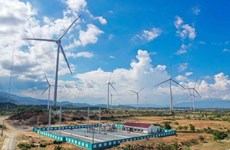Timber exports get green light
No batches of Vietnamese wooden goods have been sent back to the
country since the Lacey Act, the law requiring timber exporters and
retailers to prove the origin of its timber and related materials, took
effect from May 1.
No batches of Vietnamese wooden goods have been sent back to the
country since the Lacey Act, the law requiring timber exporters and
retailers to prove the origin of its timber and related materials, took
effect from May 1, according to the Vietnam Timber and Forest Products
Association.
Previously, Vietnam 's timber processing enterprises could export their products to the US without having to provide certificates of origin, said the association's vice chairman Nguyen Ton Quyen.
However, Vietnam 's timber exporters struggled when attempting to guarantee the point of origin of some of the timber used in its products. The association has asked the Ministry of Agriculture and Rural Development to allow commune – level authorities to grant certificates of origin for wooden goods from these areas.
For the first five months of 2010, revenue from timber exports was estimated at 1.4 billion USD, up 35 percent from the same period last year due to a growing demand in traditional markets, especially the US , Japan and China .
Many enterprises have signed contracts and made orders for the period from now until the end of 2010 and this year's selling prices have risen by 3 percent against 2009. Thus, the 3 billion USD target set for this year was within the reach, Quyen said.
There was a slight increase in the cost of imported timber but most enterprises had stockpiled materials at the beginning of the year to minimise the impacts of such an increase, he noted.
The country expects to achieve 3 billion USD in export turnover from timber products this year, 4.5 billion USD in 2015 and 7 billion USD in 2020. To attain these goals, Vietnam will have to import 4-5 million tonnes of timber annually for the next 10 years.
Quyen said that in order to raise the quality of wooden products and deal with the timber shortage, it was essential to select good woods and choose better methods to plant trees, with a focus on planting traditional varieties./.
Previously, Vietnam 's timber processing enterprises could export their products to the US without having to provide certificates of origin, said the association's vice chairman Nguyen Ton Quyen.
However, Vietnam 's timber exporters struggled when attempting to guarantee the point of origin of some of the timber used in its products. The association has asked the Ministry of Agriculture and Rural Development to allow commune – level authorities to grant certificates of origin for wooden goods from these areas.
For the first five months of 2010, revenue from timber exports was estimated at 1.4 billion USD, up 35 percent from the same period last year due to a growing demand in traditional markets, especially the US , Japan and China .
Many enterprises have signed contracts and made orders for the period from now until the end of 2010 and this year's selling prices have risen by 3 percent against 2009. Thus, the 3 billion USD target set for this year was within the reach, Quyen said.
There was a slight increase in the cost of imported timber but most enterprises had stockpiled materials at the beginning of the year to minimise the impacts of such an increase, he noted.
The country expects to achieve 3 billion USD in export turnover from timber products this year, 4.5 billion USD in 2015 and 7 billion USD in 2020. To attain these goals, Vietnam will have to import 4-5 million tonnes of timber annually for the next 10 years.
Quyen said that in order to raise the quality of wooden products and deal with the timber shortage, it was essential to select good woods and choose better methods to plant trees, with a focus on planting traditional varieties./.













